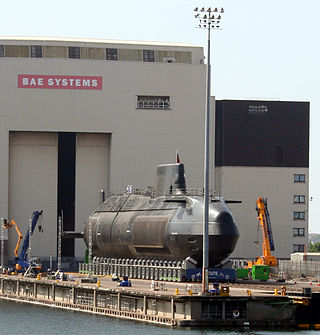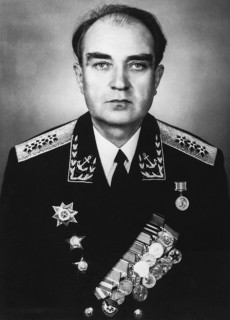
A submarine-launched ballistic missile (SLBM) is a ballistic missile capable of being launched from submarines. Modern variants usually deliver multiple independently targetable reentry vehicles (MIRVs), each of which carries a nuclear warhead and allows a single launched missile to strike several targets. Submarine-launched ballistic missiles operate in a different way from submarine-launched cruise missiles.

Petropavlovsk-Kamchatsky is a city and the administrative center of Kamchatka Krai, Russia. It is located in the far east of the country and lies along the coast of Avacha Bay by the Pacific Ocean. As of the 2021 census, it had a population of 164,900.

The Oscar class, Soviet designations Project 949 Granit and Project 949A Antey, are a series of nuclear-powered cruise missile submarines designed in the Soviet Union for the Soviet Navy. First built in the 1970s, six remain in service with the Russian Navy. Two other vessels were slated to be modernized since at least 2017 as Project 949AM, to extend their service life and increase combat capabilities but it is unclear whether work continues as of 2023.

The Kirov class, Soviet designation Project 1144 Orlan, is a class of nuclear-powered guided-missile battlecruisers of the Soviet Navy and Russian Navy, the largest and heaviest surface combatant warships in operation in the world. Among modern warships, they are second in size only to large aircraft carriers, and of similar size to a World War I-era battleship. The ships are often referred to as battlecruisers by Western defence commentators due to their size and general appearance. The Soviet classification of the ship-type is "heavy nuclear-powered guided-missile cruiser".

A ballistic missile submarine is a submarine capable of deploying submarine-launched ballistic missiles (SLBMs) with nuclear warheads. The United States Navy's hull classification symbols for ballistic missile submarines are SSB and SSBN – the SS denotes submarine, the B denotes ballistic missile, and the N denotes that the submarine is nuclear powered. These submarines became a major weapon system in the Cold War because of their nuclear deterrence capability. They can fire missiles thousands of kilometers from their targets, and acoustic quieting makes them difficult to detect, thus making them a survivable deterrent in the event of a first strike and a key element of the mutual assured destruction policy of nuclear deterrence.

K-159 was a Project 627A "Kit" nuclear-powered submarine that served in the Northern Fleet of the Soviet Navy from 1963–89. Her keel was laid down on 15 August 1962 at the Severodvinsk "Sevmash" Shipyard No. 402. She was launched on 6 June 1963, and commissioned on 9 October 1963.

K-407 Novomoskovsk is a Project 667BDRM Delfin-class ballistic missile submarine of the Russian Navy's Northern Fleet.

A nuclear submarine is a submarine powered by a nuclear reactor, but not necessarily nuclear-armed. Nuclear submarines have considerable performance advantages over "conventional" submarines. Nuclear propulsion, being completely independent of air, frees the submarine from the need to surface frequently, as is necessary for conventional submarines. The large amount of power generated by a nuclear reactor allows nuclear submarines to operate at high speed for long periods, and the long interval between refuelings grants a range virtually unlimited, making the only limits on voyage times being imposed by such factors as the need to restock food or other consumables.
R-29 Vysota is a family of Soviet submarine-launched ballistic missiles, designed by Makeyev Rocket Design Bureau. All variants use astro-inertial guidance systems.

The Delta class, Soviet designations Project 667B Murena, Project 667BD Murena-M, Project 667BDR Kalmar, Project 667BDRM Delfin, are a series of nuclear-powered ballistic missile submarines, designed and built in the Soviet Union, which formed the backbone of the Soviet and Russian strategic submarine fleet since their introduction in 1973. They carry nuclear ballistic missiles of the R-29 Vysota family, with the Delta I, Delta II, Delta III and Delta IV classes carrying the R-29, R-29D, R-29R and R-29RM respectively. The Delta I class carried 12 missiles, while the Delta II class which are lengthened versions of the Delta I class carry 16 missiles. The Delta III and Delta IV classes carry 16 missiles with multiple warheads and have improved electronics and noise reduction. 34 boats were built and commissioned during 1972–1990; approximately five or six remain active in 2023.
The Delta III-class submarine, Soviet designation Project 667BDR Kaľmar (Squid), is a large ballistic missile submarine operated by the Russian Navy. Like other previous Delta-class submarines, the Delta III class is a double hulled design, with a thin low magnetic steel outer hull wrapped around a thicker inner pressure hull.
The K-442 Chelyabinsk is an Oscar II Class SSGN of the Russian Navy.

JSC PO Sevmash is a Russian joint-stock company (JSC) under the vertically-integrated United Shipbuilding Corporation. The shipbuilding operations of Sevmash is in the port city of Severodvinsk on the White Sea in the Russian Federation.

K-433 Svyatoy Georgiy Pobedonosets is a Russian Project 667BDR Kalmar class nuclear-powered ballistic missile submarine. The submarine was built for the Soviet Navy and has continued to serve in the Russian Navy. K-433 was put in reserve in 1997 and remained there until 2004 when it was recommissioned. As of 2018, it is on active duty.

The Pacific Fleet is the Russian Navy fleet in the Pacific Ocean.
The decommissioning of Russian nuclear-powered vessels is an issue of major concern to the United States and to Scandinavian countries near Russia. From 1950 to 2003, the Soviet Union and its major successor state, Russia, constructed the largest nuclear-powered navy in the world, with more ships than all other navies combined: 248 submarines, four Kirov-class battlecruisers, and a missile test ship, as well as nine icebreakers. Many were or are powered by two reactors each, bringing the total to 468 reactors.

Emil Nikolayevich Spiridonov was an officer of the Soviet Navy. He rose to the rank of admiral and was commander of the Pacific Fleet, before his death in the 1981 Pushkin Tu-104 crash, which also killed many of the Fleet's senior officers.

The K-322 Kashalot was an Akula-class submarine in the Russian Navy.














